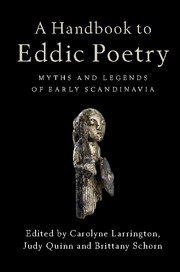Book contents
- Frontmatter
- Contents
- List of illustrations
- List of contributors
- Translations and abbreviations of the titles of eddic poems
- Introduction
- 1 The transmission and preservation of eddic poetry
- 2 Traditions of eddic scholarship
- 3 The editing of eddic poetry
- 4 The dating of eddic poetry
- 5 Eddic performance and eddic audiences
- 6 Eddic poetry and mythology
- 7 Eddic poetry and the religion of pre-Christian Scandinavia
- 8 Eddic poetry and heroic legend
- 9 Place names in eddic poetry
- 10 Eddic poetry and the imagery of stone monuments
- 11 Eddic poetry and archaeology
- 12 Eddic modes and genres
- 13 Eddic metres
- 14 Eddic style
- 15 Kennings and other forms of figurative language in eddic poetry
- 16 Alliterative lexical collocations in eddic poetry
- 17 The representation of gender in eddic poetry
- 18 The reception of eddic poetry
- Consolidated bibliography
- Index
2 - Traditions of eddic scholarship
Published online by Cambridge University Press: 05 August 2016
- Frontmatter
- Contents
- List of illustrations
- List of contributors
- Translations and abbreviations of the titles of eddic poems
- Introduction
- 1 The transmission and preservation of eddic poetry
- 2 Traditions of eddic scholarship
- 3 The editing of eddic poetry
- 4 The dating of eddic poetry
- 5 Eddic performance and eddic audiences
- 6 Eddic poetry and mythology
- 7 Eddic poetry and the religion of pre-Christian Scandinavia
- 8 Eddic poetry and heroic legend
- 9 Place names in eddic poetry
- 10 Eddic poetry and the imagery of stone monuments
- 11 Eddic poetry and archaeology
- 12 Eddic modes and genres
- 13 Eddic metres
- 14 Eddic style
- 15 Kennings and other forms of figurative language in eddic poetry
- 16 Alliterative lexical collocations in eddic poetry
- 17 The representation of gender in eddic poetry
- 18 The reception of eddic poetry
- Consolidated bibliography
- Index
Summary
This chapter characterises some types of eddic scholarship as ‘traditions’ or ‘streams (of tradition)’. It is in no way a full history of scholarship on eddic poetry; but, because traditions everywhere in cultures represent similar phenomena flowing through history, the traditions of eddic scholarship treated here can, it is hoped, suggest the lineaments of such a history. And despite academia's emphasis on originality, tradition is a force in scholarship no less than in literature or culture in general. Possibly scholars are more aware of it even than poets – who famously suffer ‘the burden of the past’ – precisely because consciousness of our traditions is or should be an integral and conscious part of our practice. The vagueness of this vocabulary – rather than, for example, ‘schools’ or ‘foci’ – has the advantage that it obviously seeks to adumbrate rather than to offer sharp differences, and in this way reflects the borderlessness of actual thought. This chapter's contribution is itself part of a tradition – albeit a humble one – of surveys of scholarship, and some of the best of its antecedents (for example, Fidjestøl, cited just below) succeeded in giving their material a historical feeling by allowing underlying binaries to exert structural force. Fully appreciative of that heritage, I nevertheless seek to avoid such structure here. No survey can absorb all its predecessors, so it is still worthwhile reading surveys of various ages and emphases, even the oldest.
At present, the single work best representing the development of eddic scholarship is an unfinished posthumous book, The Dating of Eddic Poetry from 1999, written by the Norwegian scholar Bjarne Fidjestøl and saved for us after his premature death by his colleague Odd Einar Haugen. Although Fidjestøl's specific interest is dating, the problem of how to place these poems in time, his reading was so comprehensive and his analyses so fine that the book gives the best available picture of the development of studies in eddic poetry generally, even if only through the prism of dating. Anyone interested in a more comprehensive historical view of scholarship on eddic poetry would be advised to go next after this chapter to Fidjestøl's book.
- Type
- Chapter
- Information
- A Handbook to Eddic PoetryMyths and Legends of Early Scandinavia, pp. 33 - 57Publisher: Cambridge University PressPrint publication year: 2016
- 6
- Cited by

